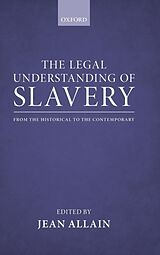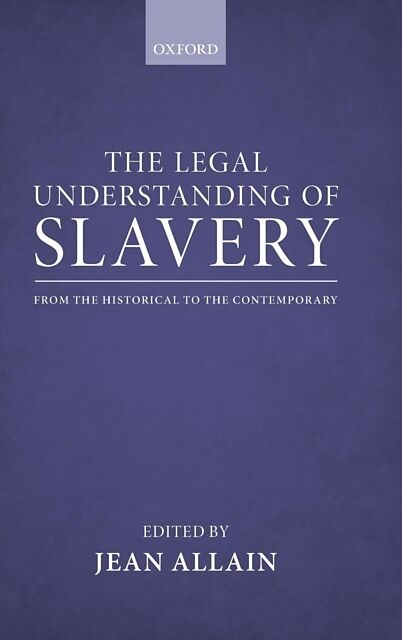The Legal Understanding of Slavery
Einband:
Fester Einband
EAN:
9780199660469
Untertitel:
From the Historical to the Contemporary
Genre:
Internationales Recht
Autor:
Jean Allain
Herausgeber:
Oxford Academic
Anzahl Seiten:
395
Erscheinungsdatum:
27.09.2012
ISBN:
978-0-19-966046-9
Zusatztext The book includes a great richness and variety of perspectives on slavery offered by some of the leading experts in this field. Informationen zum Autor Jean Allain is Professor of Public International Law at Queen's University, Belfast. He is Extraordinary Professor, Centre for Human Rights, Faculty of Law, University of Pretoria, South Africa. He is founding Editor of the Irish Yearbook of International Law and the author of The Slavery Conventions (2008) and Slavery in International Law (2012). Klappentext "Slavery is the status or condition of a person over whom any or all of the powers attaching to the right of ownership are exercised." So reads the legal definition of slavery agreed by the League of Nations in 1926. Further enshrined in law during international negotiations in 1956 and 1998, this definition has been interpreted in different ways by the international courts in the intervening years. What can be considered slavery? Should forced labour be considered slavery? Debt-bondage? Child soldiering? Or forced marriage? This book explores the limits of how slavery is understood in law. It shows how the definition of slavery in law and the contemporary understanding of slavery has continually evolved and continues to be contentious. It traces the evolution of concepts of slavery, from Roman law through the Middle Ages, the 18th and 19th centuries, up to the modern day manifestations, including manifestations of forced labour and trafficking in persons, and considers how the 1926 definition can distinguish slavery from lesser servitudes. Together the contributors have put together a set of guidelines intended to clarify the law where slavery is concerned. The Bellagio-Harvard Guidelines on the Legal Parameters of Slavery, reproduced here for the first time, takes their shared understanding of both the past and present to project a consistent interpretation of the legal definition of slavery for the future. Zusammenfassung This book examines how slavery is understood in law. It shows how the legal definition of slavery has evolved and continues to be contentious. It traces the understanding of slavery from Roman law through the Middle Ages, the 18th and 19th centuries, up to the modern day manifestations, including forced labour and trafficking in persons. Inhaltsverzeichnis Bellagio-Harvard Guidelines on the Legal Parameters of Slavery Introduction Section 1: Historical Readings of the Law of Slavery 1: Antony HonorÃ(c): The Nature of Slavery 2: Richard Helmholz: The Law of Slavery in European ius commune 3: Bernard Freamon: Definition and Conceptions of Slave Ownership in Islamic Law 4: John Cairns: The Definition of Slavery in Eighteenth-Century Thinking: Not the True Roman Slavery 5: Seymour Drescher: From Consensus to Consensus: Slavery in International Law Section 2: The American Experience: Blurred Boundaries of Slavery 6: Paul Finkelman: Slavery in the United States: Persons or Property?, 7: Allison Mileo Gorsuch: To Indent Oneself: Ownership, Contracts, and Consent in Antebellum Illinois 8: Rebecca Scott: Under Color of Law: Siliadin v. France and the Dynamics of Enslavement in Historical Perspective 9: Stanley Engerman: The Rise, Persistence, and Slow Decline of Legal Slavery 10: William M. Carter, Jr.: The Abolition of Slavery in the United States: Historical Context and its Contemporary Application Section 3: The 1926 Definition in Context 11: Jean Allain: The Definition of Slavery into the Twenty-First Century 12: Robin Hickey: Seeking to Understand the Definition of Slavery 13: J. E. Penner: The Concept of Property and the Concept of Slavery 14: Joel Quirk: Defining Slavery in all its Forms: Historical Inquiry as Contemporary Instruction Section 4: Contemporary Slavery 15: Kevin Bales: Slavery in its Contemporary Manifestations 16: Holly...
Autorentext
Jean Allain is Professor of Public International Law at Queen's University, Belfast. He is Extraordinary Professor, Centre for Human Rights, Faculty of Law, University of Pretoria, South Africa. He is founding Editor of the Irish Yearbook of International Law and the author of The Slavery Conventions (2008) and Slavery in International Law (2012).
Klappentext
"Slavery is the status or condition of a person over whom any or all of the powers attaching to the right of ownership are exercised."
So reads the legal definition of slavery agreed by the League of Nations in 1926. Further enshrined in law during international negotiations in 1956 and 1998, this definition has been interpreted in different ways by the international courts in the intervening years. What can be considered slavery? Should forced labour be considered slavery? Debt-bondage? Child soldiering? Or forced marriage?
This book explores the limits of how slavery is understood in law. It shows how the definition of slavery in law and the contemporary understanding of slavery has continually evolved and continues to be contentious. It traces the evolution of concepts of slavery, from Roman law through the Middle Ages, the 18th and 19th centuries, up to the modern day manifestations, including manifestations of forced labour and trafficking in persons, and considers how the 1926 definition can distinguish slavery from lesser servitudes.
Together the contributors have put together a set of guidelines intended to clarify the law where slavery is concerned. The Bellagio-Harvard Guidelines on the Legal Parameters of Slavery, reproduced here for the first time, takes their shared understanding of both the past and present to project a consistent interpretation of the legal definition of slavery for the future.
Zusammenfassung
This book examines how slavery is understood in law. It shows how the legal definition of slavery has evolved and continues to be contentious. It traces the understanding of slavery from Roman law through the Middle Ages, the 18th and 19th centuries, up to the modern day manifestations, including forced labour and trafficking in persons.
Inhalt
Bellagio-Harvard Guidelines on the Legal Parameters of Slavery
Introduction
Section 1: Historical Readings of the Law of Slavery
1: Antony HonorÃ(c): The Nature of Slavery
2: Richard Helmholz: The Law of Slavery in European ius commune
3: Bernard Freamon: Definition and Conceptions of Slave Ownership in Islamic Law
4: John Cairns: The Definition of Slavery in Eighteenth-Century Thinking: Not the True Roman Slavery
5: Seymour Drescher: From Consensus to Consensus: Slavery in International Law
Section 2: The American Experience: Blurred Boundaries of Slavery
6: Paul Finkelman: Slavery in the United States: Persons or Property?,
7: Allison Mileo Gorsuch: To Indent Oneself: Ownership, Contracts, and Consent in Antebellum Illinois
8: Rebecca Scott: Under Color of Law: Siliadin v. France and the Dynamics of Enslavement in Historical Perspective
9: Stanley Engerman: The Rise, Persistence, and Slow Decline of Legal Slavery
10: William M. Carter, Jr.: The Abolition of Slavery in the United States: Historical Context and its Contemporary Application
Section 3: The 1926 Definition in Context
11: Jean Allain: The Definition of Slavery into the Twenty-First Century
12: Robin Hickey: Seeking to Understand the Definition of Slavery
13: J. E. Penner: The Concept of Property and the Concept of Slavery
14: Joel Quirk: Defining Slavery in all its Forms: Historical Inquiry as Contemporary Instruction
Section 4: Contemporary Slavery
15: Kevin Bales: Slavery in its Contemporary Manifestations
16: …

Leider konnten wir für diesen Artikel keine Preise ermitteln ...
billigbuch.ch sucht jetzt für Sie die besten Angebote ...
Die aktuellen Verkaufspreise von 6 Onlineshops werden in Realtime abgefragt.
Sie können das gewünschte Produkt anschliessend direkt beim Anbieter Ihrer Wahl bestellen.
Loading...
Die aktuellen Verkaufspreise von 6 Onlineshops werden in Realtime abgefragt.
Sie können das gewünschte Produkt anschliessend direkt beim Anbieter Ihrer Wahl bestellen.
| # | Onlineshop | Preis CHF | Versand CHF | Total CHF | ||
|---|---|---|---|---|---|---|
| 1 | Seller | 0.00 | 0.00 | 0.00 |
